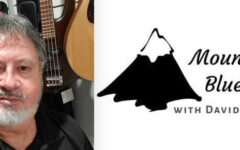
 Yesterday afternoon at World of Bluegrass, WAMU’s Bluegras Country Program Director Chris Teskey moderated a panel discussion with a number of bluegrass radio notables. Billed as State of the Industry: Bluegrass Radio & Charts, the primary focus of the session was presenting artists and record labels with the opportunity to hear from programmers about how new music is chosen for airplay.
Yesterday afternoon at World of Bluegrass, WAMU’s Bluegras Country Program Director Chris Teskey moderated a panel discussion with a number of bluegrass radio notables. Billed as State of the Industry: Bluegrass Radio & Charts, the primary focus of the session was presenting artists and record labels with the opportunity to hear from programmers about how new music is chosen for airplay.
Sitting on the panel were Kyle Cantrell from Sirius XM, Terry Herd from Into The Blue (and Bluegrass Today), Gene Skinner from Great Stuff Radio and Pete Kuykendall from Bluegrass Unlimited. Those of you who follow bluegrass radio might wonder what the publisher of a print magazine was doing on a radio panel. Pete was filling in for Lee Michael Demsey of WAMU, who compiles the chart for the magazine, and was unable to attend due to a family medical issue.
Herd and Skinner host widely-syndicated programs, with dozens to hundreds of stations, and Cantrell has a vast reach with Bluegrass Junction on Sirius XM, running bluegrass music 24/7 on satellite. Bluegrass Country, where Teskey and Demsey toil, send out a non-stop bluegrass stream online.
In the audience were a number of artists, representatives from at least two labels, and a handful of long time broadcasters. Both prepared topics and participant questions brought out a number of points relating to getting songs chosen for radio play.
Quality packaging really makes a difference: as Cantrell mentioned, “if you don’t show much pride in your packaging, what makes me think you take much in your music?”
All the DJs made clear that if a song doesn’t capture their attention within the first 15-20 seconds, they will move on to the next track. If nothing grabs them in the first few tracks, they aren’t likely to go any deeper. Though not stated explicitly, the tenor of the conversation was that getting the attention of influential broadcasters involves a different set of considerations than appealing to your fan base or a live audience.
In response to questions in the room, each panelist indicated that including a note suggesting certain tracks for consideration is a big help, but as Terry pointed out, “you had better make sure they are really good, because if we listen to the track you suggest and it doesn’t grab us, we will most likely set the CD aside.”
Teskey also mentioned that when an artist or publicist has taken the time to become familiar with an individual show, and can suggest tracks that are in fact a good fit, most programmers will put that one at the top of the pile for consideration.
And getting a CD from a known entity is a big plus. All agreed that a project from a label makes it more likely to be considered, as does communication from a publicist who is known to the broadcaster. Skinner made the point that having been filtered by other industry professionals adds credibility to a new arrival, and choosing a publicist who has been reliable in the past in sharing quality music gives you an edge.
Teskey added that the radio and distribution world came up with the term “one sheet” for a reason. Get all the relevant information on a single sheet of paper, and include it with a CD for submission – and just that. Cantrell said that “we don’t need your life story,” and that he often has to review new submissions while multi-tasking. Just the facts, ma’am.
My own take from this discussion? Recognize that radio programmers lead busy lives, and have a good many new albums to consider each week. Give them the information they need to make a decision about yours in a few minutes, don’t waste their time with unnecessary details, and help them see which tracks might be a good bet for their show.
At the close of the seminar the conversation turned to charts in our industry. Teskey opened by listing the top albums this week on the Billboard bluegrass chart, few of which fell squarely in what most would consider the bluegrass mainstream. His point was that how a chart is compiled, and what it measures, is crucial to understanding its implications. Billboard measures sales as reported by Soundscan (bar code readings), and places artists into categories of their own choosing.
Herd and Kuykendall then described what their charts report. BU does a monthly survey of radio hosts who give a top 10 based on what they have been playing, and what is being requested by listeners. Their National Bluegrass Survey chart is available in the magazine each month.
For the Bluegrass Today chart, programmers report actual spins weekly, with the data weighted for syndication and reach. Then, a monthly chart is compiled based on the weekly data, with both posted regularly on the site. The weekly chart is available each Friday morning, with the monthly posted at the end of the month.
From my perspective, this was a very valuable session, one that gave artists and labels a clear understanding of what radio is after, and allowed other radio hosts to air their frustrations with what they receive. Just the sort of networking that World of Bluegrass excels in providing.







